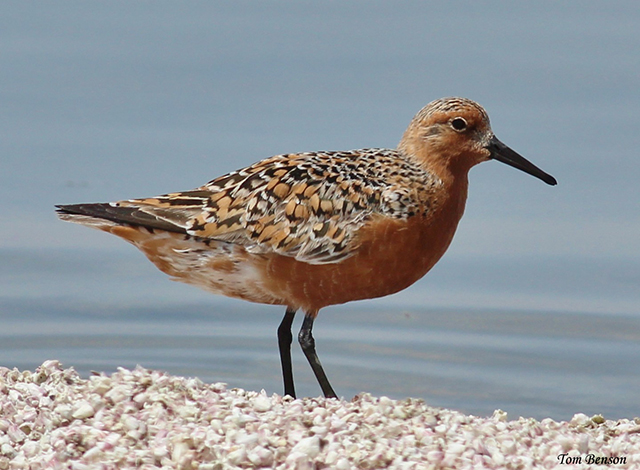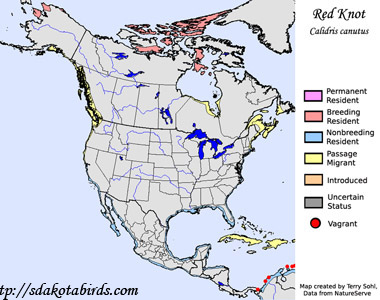| Length: 10 to 11 inches | Wingspan: 20 inches | Seasonality: Migrant |
| ID Keys: Face and underparts have robin-red in breeding plumage. Winter plumage very plain without obvious markings. They are larger than most of the other plain (winter) sandpipers. | ||
 The Red Knot is
unmistakable in its summer plumage, with robin-red coloring on its face and
underparts, but is quite plain in its winter plumage (see photo to the right).
They were once one of the most common of North American shorebirds, but they
were slaughtered by the thousands during the 1800's. They are
relatively rare migrants on the interior of the continent.
The Red Knot is
unmistakable in its summer plumage, with robin-red coloring on its face and
underparts, but is quite plain in its winter plumage (see photo to the right).
They were once one of the most common of North American shorebirds, but they
were slaughtered by the thousands during the 1800's. They are
relatively rare migrants on the interior of the continent.
Habitat: Nests on the Arctic Tundra. In migration and in winter, they are most often found on coastal and other mudflats, as well as occasionally being found on sandy beaches.
Diet: Feeds primarily on insects and insect larvae on it's summer breeding grounds, along with seeds, leaves, and fresh buds. In winter and in migration, feeds heavily on small mollusks, crustaceans, and marine worms.
Behavior: Forages by walking on mudflats, beaches, or shallow water. Food items are often obtained by probing in the mud with their bill, but they also will pick up food items from the water surface or ground.
Breeding: Non-breeder in South Dakota
Song: Generally silent, but feeding birds and those in flight may utter a harsh krut.
Migration: Summers throughout the high Arctic. Some winter on U.S. coastlines, but many more migrate to southern South America, some to Australia, and still others may winter in Europe. Most migrate along the Atlantic coast, with only small numbers migrating inland.
Interactive eBird Map: Click here to access an interactive eBird map of Red Knot sightings
Similar Species: Curlew Sandpiper (not found in South Dakota), Sanderling
Conservation Status: Hunting in the 1800's killed very large numbers of these birds, and numbers have never recovered to historical levels. In addition, the species has seen steepdeclines since the 1960's. This is probably due to over harvesting of Horseshoe Crabs on key staging areas for Red Knots in migration. They depend heavily on nutrient rich Horseshoe Crab eggs during migration, and suffer if that food source isn't as readily available.
Further Information: 1) Patuxent Bird Identification InfoCenter, Red Knot
Photo Information: Photo courtesy of Tom Benson.
| Click on the map below for a higher-resolution view |
 |
| South Dakota Status: Casual spring migrant in the east, accidental in the west. Accidental fall migrant. |
Additional Red Knot Photos (coming soon!)
